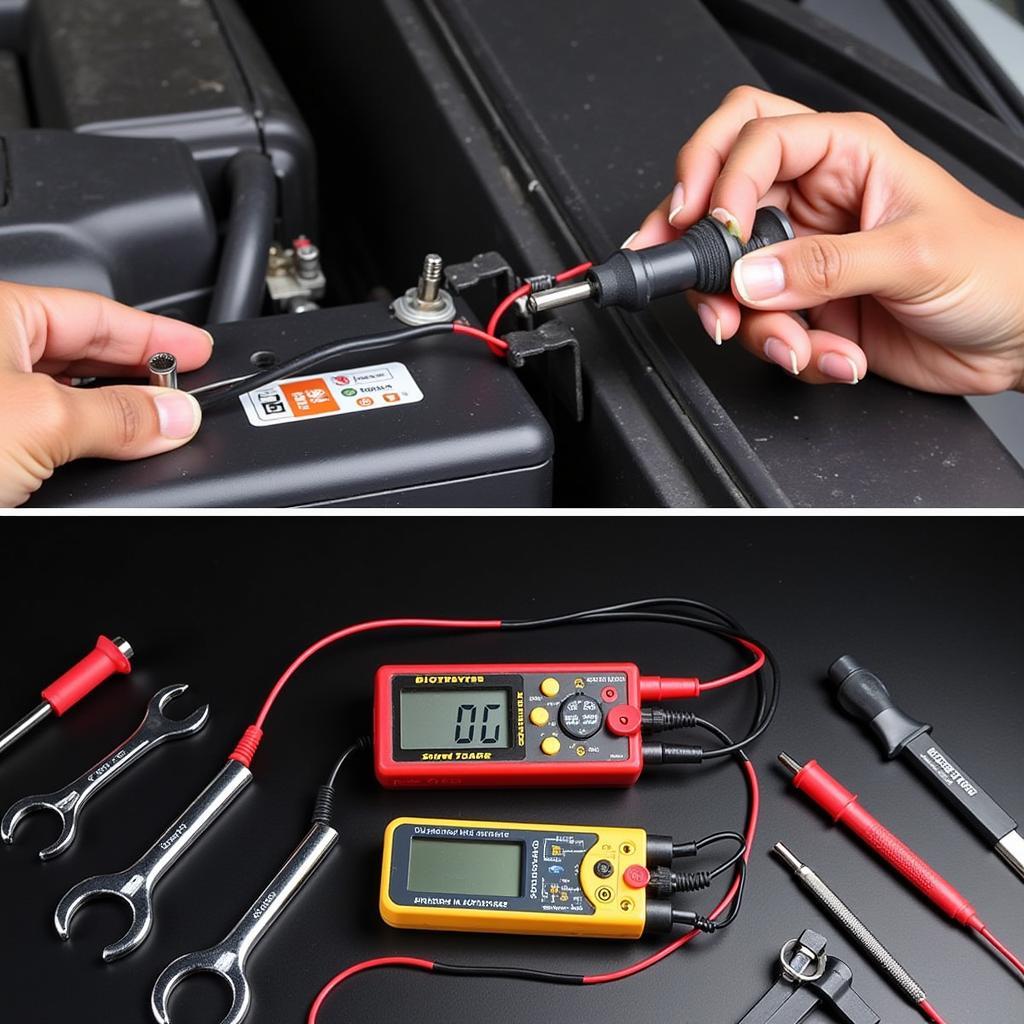A parasitic draw, also known as a parasitic battery drain, can be a frustrating and often elusive problem in modern vehicles. It occurs when an electrical component continues to consume power even after the vehicle is turned off, leading to a dead battery. This article provides a comprehensive guide to understanding, parasitic electrical drain, and ultimately resolving this common automotive issue.
Understanding how to diagnose a parasitic draw is essential for any car owner. A parasitic leak battery can leave you stranded and cause significant inconvenience. Fortunately, with the right tools and knowledge, you can often pinpoint the source of the drain yourself.
 Diagnosing parasitic draw with a multimeter
Diagnosing parasitic draw with a multimeter
What Causes a Parasitic Draw?
Several factors can contribute to a parasitic draw. Faulty wiring, malfunctioning relays, or even aftermarket accessories improperly installed can drain your battery. A common culprit is a glove box light or trunk light that stays on due to a faulty switch. Even seemingly minor issues, like a stuck window motor or a malfunctioning radio, can contribute to a maximum parasitic draw.
Identifying the Symptoms of a Parasitic Draw
The most obvious symptom is a dead battery, especially if it’s relatively new. Other symptoms include dimming headlights, slow cranking, and electrical components behaving erratically. However, these symptoms can also indicate other problems, so a proper diagnosis is crucial.
“A common mistake people make is assuming a dead battery is always due to a failing battery,” explains automotive electrical expert, John Smith, ASE Certified Master Technician. “Often, it’s a parasitic draw slowly draining the life out of a perfectly good battery.”
How to Diagnose a Parasitic Draw
Diagnosing a parasitic draw requires a systematic approach. First, you need a digital multimeter, preferably one with a milliamp setting. Next, disconnect the negative battery cable and connect the multimeter in series between the negative battery terminal and the disconnected cable. Observe the reading on the multimeter.
Interpreting the Multimeter Readings
A normal parasitic draw is typically around 25-50 milliamps. Anything significantly higher suggests a problem. If you’re seeing a higher reading, you can begin isolating circuits by removing fuses one at a time and observing the multimeter reading. When the reading drops significantly, you’ve likely identified the circuit with the parasitic draw.
“Finding the right fuse can be a process of elimination,” advises Jane Doe, Senior Electrical Engineer at AutoTech Solutions. “Patience and methodical testing are key.”
Tools for Diagnosing Parasitic Draw
While a multimeter is the primary tool, other tools can aid in the diagnosis. A test light can be useful for quickly checking for power in a circuit. A wiring diagram specific to your vehicle model is indispensable for tracing circuits and identifying components.
Using a Multimeter to Test Parasitic Battery Drain Multimeter
The multimeter is the cornerstone of parasitic draw diagnosis. By measuring the current flow with the ignition off, you can pinpoint the culprit circuit. Remember to always consult your vehicle’s service manual for specific instructions and acceptable current draw levels.
Conclusion
Diagnosing a parasitic draw doesn’t have to be a daunting task. With a basic understanding of the process and the right tools, you can effectively identify and resolve this common car problem, saving yourself time, money, and the frustration of a dead battery. Remember, addressing a parasitic draw promptly will not only prevent unexpected breakdowns but also prolong the life of your car battery.
FAQ
-
What is a parasitic draw? A parasitic draw is an electrical current drain that occurs even when the car’s ignition is off.
-
What are the common causes of a parasitic draw? Faulty relays, interior lights, aftermarket accessories, and even a faulty clock can cause a parasitic draw.
-
How do I test for a parasitic draw? Use a digital multimeter to measure the current drain with the ignition off.
-
What is a normal parasitic draw? Typically, a normal parasitic draw is between 25 and 50 milliamps.
-
What should I do if I find a parasitic draw? Identify the circuit causing the draw by removing fuses one by one and checking the multimeter reading.
-
Can a parasitic draw damage my car battery? Yes, a continuous parasitic draw can drain and eventually damage your car battery.
-
Do I need professional help to diagnose a parasitic draw? While you can often diagnose it yourself, if you are uncomfortable working with electrical systems, it’s best to consult a qualified mechanic.

